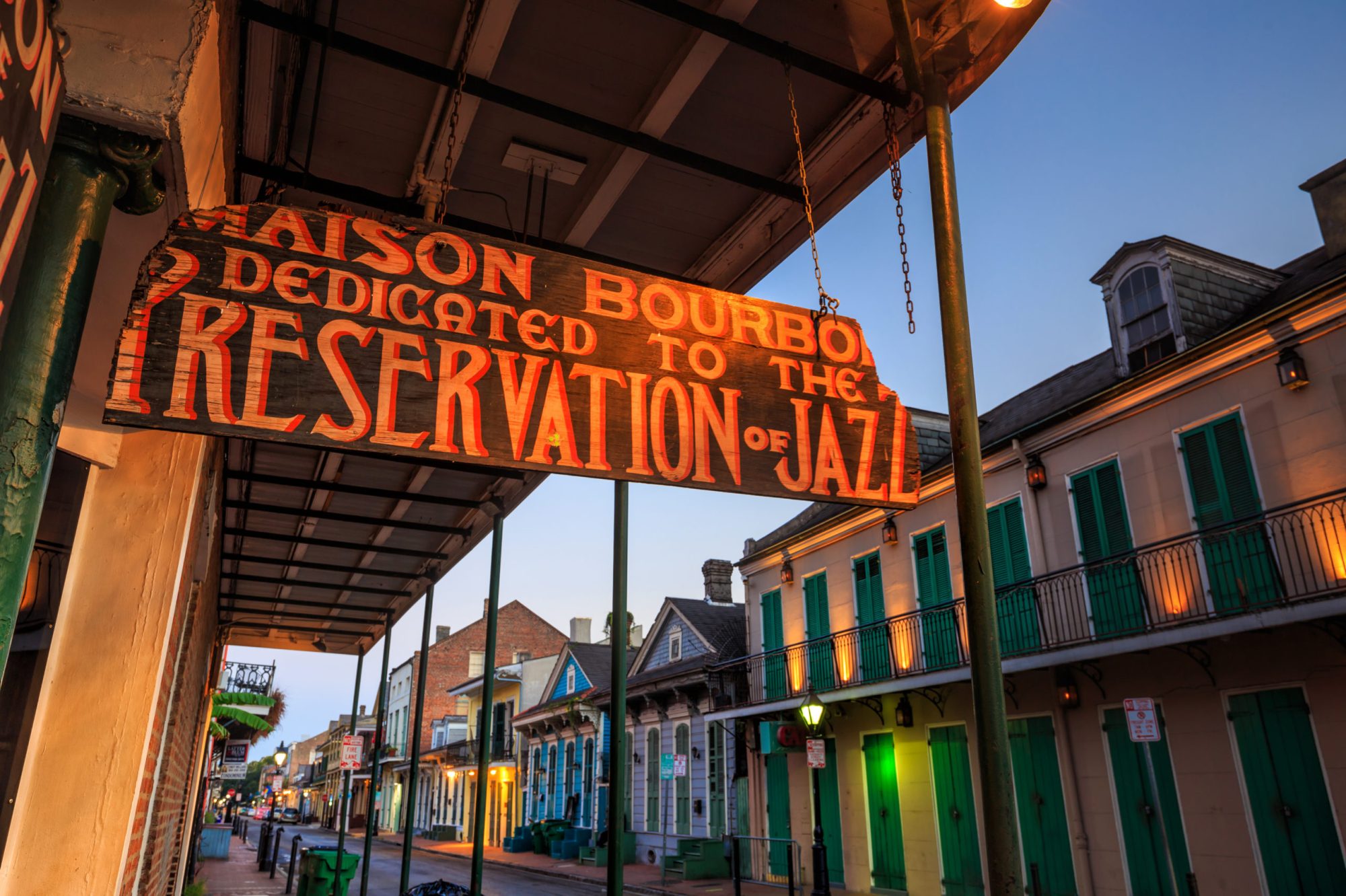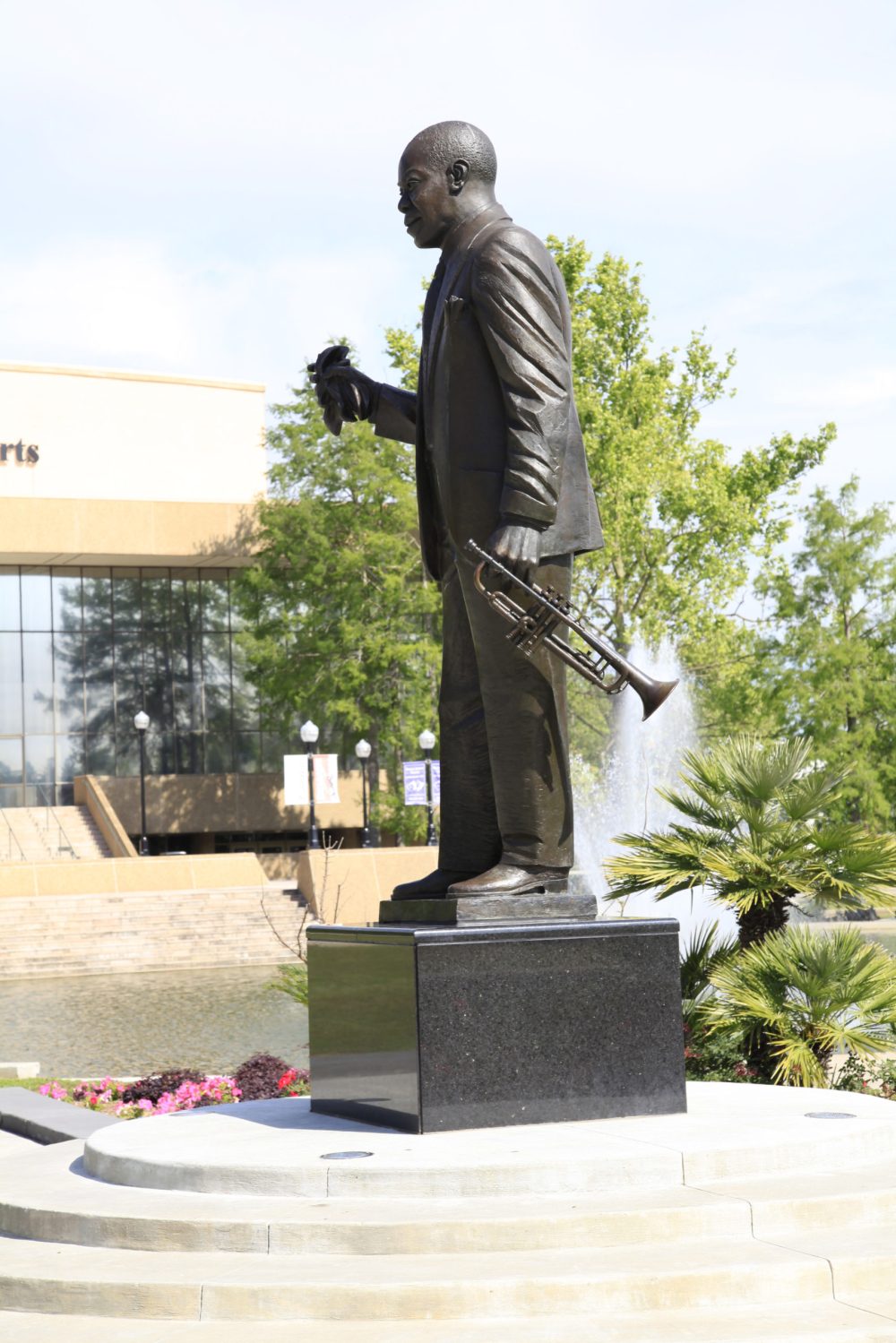Famous New Orleans Musicians Who Shaped the City’s Musical Legacy

Music is a way of life in New Orleans. Known as the birthplace of jazz, the Crescent City uses music to celebrate, mourn, and make history. New Orleans’ most influential musicians span multiple decades and genres, from the jazz artists of the 1920s to modern hip hop icons. Soul, R&B, and rock and roll are some of the most popular musical styles still playing at clubs and dance halls around the city, thanks to famous musicians and singers like Fats Domino and Ernie K-Doe.
Whether you’re visiting the Tremé neighborhood or stepping into a Frenchmen Street jazz bar, you can’t help swaying to the rhythm of New Orleans’ musical legacy. Read on to get to know some of the artists who are still celebrated today.
Louis Armstrong

We couldn’t write about famous musicians from New Orleans without kicking things off with Louis Armstrong, arguably the city’s most famous celebrity and one of the most influential jazz musicians of all time. Known for his trumpet prowess, Armstrong actually began his musical studies with the cornet, a brass instrument similar to the trumpet. At the young age of 11, under the instruction of music teacher Peter Davis, Armstrong mastered the instrument and set his sights on playing music professionally. He soon became one of New Orleans’ top cornetists, regularly entertaining guests on riverboats.
As his career progressed throughout the 1920s and later, Armstrong made a name for himself in cities like New York and Chicago, where he began producing records and growing a following. Nicknamed “Satchmo,” Armstrong was known for his larger-than-life stage presence and skillful scat singing with his distinct, gravelly voice. He was also adept at improvising, able to bend the melody of a song and make it his own.
He was one of the first popular African-American entertainers to enter the mainstream music scene, and he had gained immense popularity among white and international audiences by the end of his life. Today, he remains a favorite New Orleans music icon. In fact, the city honors him with a public park near the French Quarter with statues and sculptures, duck ponds, and open seating areas. Even the airport is named after him!
Visit Louis Armstrong Park on a jazz tour!
Fats Domino
Born in 1928, Antoine Dominique Domino (known as Fats Domino) was a singer-songwriter and pianist who is known for being one of the pioneers of rock and roll music. Throughout his lifetime, he sold more than 65 million records and had 11 Top 10 US pop hits between 1955 and 1960. In fact, Elvis Presley even called Domino “the real king of rock ‘n’ roll” and said that Domino was a huge influence on him when he was just starting out in his own music career. Some records of Domino’s you might recognize include “Blueberry Hill,” “Walking To New Orleans,” “The Fat Man,” and “Ain’t it A Shame.”
Domino’s New Orleans roots ran deep. Louisiana Creole was his first language, and he continued to live in his childhood, predominantly working-class neighborhood, the Lower Ninth Ward, even after his success. (He moved to a NOLA suburb following Hurricane Katrina). Neighbors were used to spotting him driving around in his bright pink Cadillac.
Domino loved New Orleans so much that, following a tour in Europe, he declared he would not leave NOLA again because he couldn’t get any food he liked anywhere else. He was inducted into the Louisiana Music Hall of Fame in 2007. When he passed away in 2017, New Orleans residents celebrated his life with an extensive parade outside of his house.
Trombone Shorty

One of New Orleans’ most popular modern brass musicians is Troy Andrews, a.k.a. Trombone Shorty. His musical style is a blend of funk, jazz, hip hop, and soul, paying homage to artists like Louis Armstrong while creating his own unique sound. Andrews was raised in the Tremé neighborhood, known as the birthplace of jazz and home to soulful jazz and dance clubs. He got his stage name at the age of 4 when he picked up a trombone and started building the musical skills that would launch his career. By age 8, he was leading his own band in parades and even bars.
During his teen years, Andrews played shows abroad with the Neville Brothers and joined Lenny Kravitz’s band. Throughout his career, he’s collaborated with many singers and musicians like Aloe Blacc, U2, Kevin Griffin, Alex Ebert, and others. His 2010 album Backatown was nominated for the Grammy Award for Best Contemporary Jazz Album.
Visit the Tremé neighborhood and learn about Trombone Shorty’s birthplace on a music and cultural tour.
Irma Thomas
Known as the Soul Queen of New Orleans, blues singer Irma Thomas discovered her passion for song as a teen when she sang with a gospel quartet and Baptist church choir. She got her big break in 1959 when band leader Tommy Ridgley noticed her talents while she was waitressing at New Orleans’ Pimlico Club. She actually lost her job for singing with Ridgley instead of waiting on tables! But the gamble paid off – the band leader got her a recording contract with a local label. In 1960, her debut single “You Can Have My Husband, But Please Don’t Mess With My Man” climbed to #22 on the Billboard R&B charts.
Now a Grammy Award-winning artist in her 80s, Thomas has collaborated with famous artists like Allen Toussaint, Marcia Ball, and others. Her style is often compared to that of Aretha Franklin and Etta James. From winning the Ritz Theater’s talent night in her youth to several Grammy nominations later in her career, Thomas’ passion for singing has continued throughout her life. She performed well into her 70s and recently sang at a wedding and taped several holiday webcasts. The Soul Queen still sings every Sunday at her church in New Orleans.
Allen Toussaint
New Orleans rhythm and blues musician Allen Toussaint did a little bit of everything — he was a singer, songwriter, arranger and record producer who composed songs for singers Irma Thomas, Ernie K-Doe, Aaron Neville, and more. Popular hits of his include “I Like It Like That,” “Southern Nights,” and “Here Come The Girls,” among others. His influential career took off in the 1950s and spanned well to the end of the century. In fact, he passed away while on tour in Spain at the age of 77. Throughout his life, he produced hundreds of recordings and became known as “one of popular music’s great backroom figures.”
Growing up in the Gert Town neighborhood of New Orleans, Toussaint received instruction from many musicians at a young age. He learned to play piano, performed in a band as a teen, and began making recordings in 1957 after being introduced to a group of local musicians who helped him make a name for himself. He was a popular musician in New Orleans who is still remembered today.
Learn more about 50s R&B and the NOLA music scene today on the Music Legacy Tour.
Ernie K-Doe
Flashy performer Ernie K-Doe is responsible for one of the biggest hits to ever come out of New Orleans: the 1961 number one Billboard hit “Mother-in-Law,” written by Allen Toussaint. (The song reached number one on both the Billboard pop chart and Billboard R&B chart). The rhythm and blues singer was born in 1933, and he first recorded as a member of the Blue Diamonds before making his debut solo recordings. Although he never had another top-40 pop hit, he produced several other top-40 R&B hits throughout his lifetime.
By the 1990s, K-Doe was well known in New Orleans for his eccentric appearance and flamboyant personality. He was an elaborate showman who performed in bright clothing and a gold cape made by his wife, Antoinette. He even coined several catch phrases including “Burn, K-Doe, Burn,” which he frequently used in energetic self-promotions in his radio shows on two New Orleans community stations. His top hit “Mother-in-Law” was the namesake for the Mother-in-Law Lounge he opened in 1994, where he performed until his death in 2001. Today, the club remains a popular spot for music lovers and is currently run by trumpeter Kermit Ruffins.
There are so many more notable singers, artists, and bands like The Meters, the Preservation Hall Jazz Band, Dr. John, and more. New Orleans will always be associated with jazz, but these music icons give the city many other claims to fame in the genres of R&B and rock and roll. You can still hear their influences in the city’s many parades and clubs. Want to explore the New Orleans music scene yourself? Step into a jazz club, visit Congo Square, or take a tour to learn about famous New Orleans musicians from an expert.
